第二章-口腔流行病学
口腔预防医学教学课件:第二章口腔流行病学
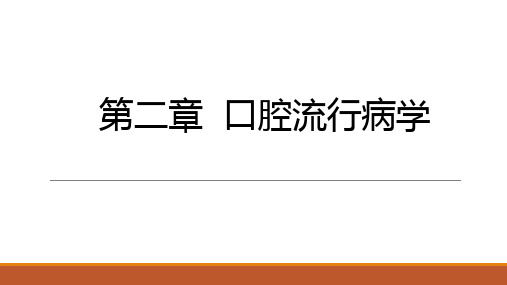
二、口腔健康调查项目
一般项目 姓名、性别、年龄、职业、民族、籍贯、文化程度、经济状况、宗
教信仰等
口腔健康状况项目 龋病、牙周病、牙列状况 问卷调查项目 口腔卫生知识、态度和信念、行为和实践
三、指数与标准
根据调查目的确定使用的指数和调查标准。常用的 龋病指数有DMFT、DMFS等,牙周健康状况用CPI指数,氟牙 症用Dean指数。
(一)病例对照研究
病例组
对照组
回顾性搜集资料
比较两组中某因素 的比例高低
统计分析
比较暴露因素与疾病的 发生是否有关
病例对照研究的特点:
①是在疾病发生后进行的; ②研究对象是按有病与否分成病例组和对照组; ③属回顾性研究; ④由果推因,即发病与暴露的可能关联 ⑤只能了解两组的暴露率或暴露水平
(二)群组研究(队列研究) 暴露组
金标准、国际标准、国家标准、行业标准等
*
*
四、口腔健康调查方法
(一) 普 查 (二)抽样调查 (三)预调查 (四)捷径调查
*
*
(一) 普查
普查是指在特定时间范围内,一般为1~2天或1~2周。对特 定人群中的每一个成员进行的调查或检查,又称全面调查。
最大优点:发现调查人群中的全部病例。 应查率<95%;漏查率高结果可靠性差。
第二章 口腔流行病学
第一节 口腔流行病学
口腔流行病学定义
口腔流行病学是流行病学的一个分支,是用流行病 学的原则、基本原理和方法,研究口腔疾病在人群中发 生、发展、分布的规律及其影响因素的一门学科。
口腔流行病学的作用
1、描述人群口腔健康与疾病的分布状态 2、研究口腔疾病病因和影响流行的因素 3、研究疾病预防措施并评价其效果 4、监测口腔疾病的发展趋势 5、制订口腔卫生保健规划并评价其进展
第二章 基本口腔流行病学
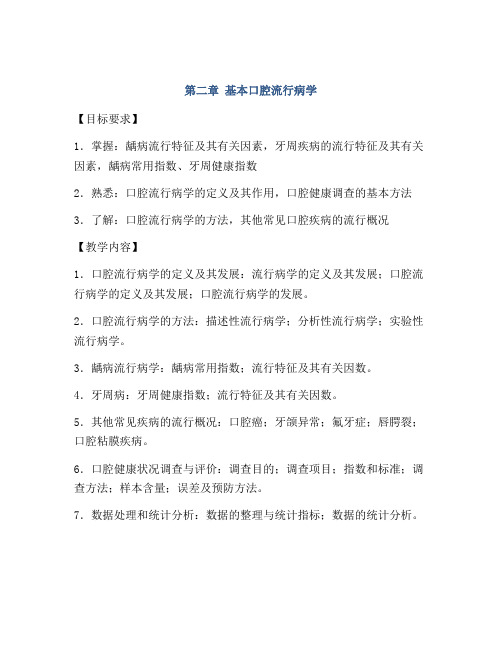
第二章基本口腔流行病学
【目标要求】
1.掌握:龋病流行特征及其有关因素,牙周疾病的流行特征及其有关因素,龋病常用指数、牙周健康指数
2.熟悉:口腔流行病学的定义及其作用,口腔健康调查的基本方法3.了解:口腔流行病学的方法,其他常见口腔疾病的流行概况
【教学内容】
1.口腔流行病学的定义及其发展:流行病学的定义及其发展;口腔流行病学的定义及其发展;口腔流行病学的发展。
2.口腔流行病学的方法:描述性流行病学;分析性流行病学;实验性流行病学。
3.龋病流行病学:龋病常用指数;流行特征及其有关因数。
4.牙周病:牙周健康指数;流行特征及其有关因数。
5.其他常见疾病的流行概况:口腔癌;牙颌异常;氟牙症;唇腭裂;口腔粘膜疾病。
6.口腔健康状况调查与评价:调查目的;调查项目;指数和标准;调查方法;样本含量;误差及预防方法。
7.数据处理和统计分析:数据的整理与统计指标;数据的统计分析。
口腔预防医学第二章口腔流行病学
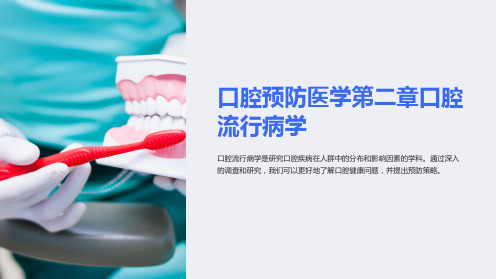
结论和展望
通过口腔流行病学的研究,我们可以更好地了解口腔健康问题,并制定出科 学有效的预防策略。未来,口腔流行病学将继续发展,为口腔预防工作提供 更多支持。
口腔流行病学的研究对象
口腔流行病学的研究对象包括不同年龄、性别、社会经济地位、职业等不同 特征的人群。研究对象的选择决定了调查和研究的针对性和实用性。
口腔流行病学的研究方法
口腔流行ቤተ መጻሕፍቲ ባይዱ学采用多种研究方法,包括调查问卷、流行病学调查、实验研究 等,通过这些方法可以获取大量的口腔健康数据,并进行统计和分析。
口腔疾病的流行病学特征
口腔疾病的流行病学特征包括发病率、死亡率、影响因素等方面的信息。了 解这些特征可以帮助我们更好地了解口腔疾病的传播和预防。
口腔健康的流行病学调查
口腔健康的流行病学调查是评估人群口腔健康状况的重要手段,通过调查和 检查,可以了解人群的口腔健康问题,并提出针对性的改进措施。
口腔流行病学在口腔预防医学 中的应用
口腔预防医学第二章口腔 流行病学
口腔流行病学是研究口腔疾病在人群中的分布和影响因素的学科。通过深入 的调查和研究,我们可以更好地了解口腔健康问题,并提出预防策略。
口腔流行病学概述
口腔流行病学是一门与口腔疾病发生、发展、传播以及防控相关的学科,通过分析大量的数据,可以揭示出口腔疾 病在人群中的分布规律。
口腔流行病学

第一节内容概要一、口腔流行病学的概念、作用及其发展(一)口腔流行病学的概念口腔流行病学是流行病学的一个分支,即用流行病学的原则、基本原理和方法,研究人群中口腔疾病发生、发展和分布的规律及其影响因素。
(二)口腔流行病学的作用1.描述人群口腔健康与疾病的分布状态2.研究口腔疾病的病因和影响流行的因素。
3.研究疾病预防措施并评价其效果4.监测口腔疾病流行趋势。
5.病例-特点:①1.(DMFS)2.3.4.5.6.龋病发病率指至少在1年时间内,某人群新发生龋病的频率。
7.无龋率指全口牙列均无龋的人数占全部受检查人数的百分率。
(二)流行特征及其影响因素1.龋病的流行特征从地区分布上看,各国龋病患病率差别悬殊。
从时间分布上看,发达国家患龋率逐渐下降,发展中国家龋病患病率逐渐上升。
从人群分布看,乳牙、年轻恒牙和老年人牙龈退缩后的恒牙易感龋病。
乳牙患龋率男性略高于女性,而恒牙患龋率女性略高于男性。
一般城市居民的患龋率高于农村。
民族之间的患龋情况不同。
2.影响龋病流行的因素常见的因素包括社会经济因素、氟摄入量、饮食习惯和家族影响。
四、牙周病流行病学(一)牙周健康指数1.简化口腔卫生指数(OHIS)是?Greene和?Vermillion对他们在1960年提出的口腔卫生指数(OHI)加以简化而成。
OHI-S只检查6个牙面,包括简化软垢指数(D1-S)和简化牙石指数(CI-S)。
2.菌斑指数(PLI)是根据牙面菌斑的厚度而不根据菌斑覆盖面积计分。
可检查全口牙面,也可检查选定的几颗牙。
每颗牙检查4个牙面,每颗牙的计分为4个牙面计分之和除以4,个人计分为每颗牙计分之和除以受检牙数。
3.?Turesky改良的Q-H菌斑指数先用菌斑染色剂使菌斑染色,再检查指定的六颗牙的牙面菌斑面积得到计分。
4.牙龈指数(GI)只观察牙龈情况,检查牙龈颜色和质的改变,以及出血倾向。
5.龈沟出血指数(SBI)检查用视诊、探诊相结合的方法,所用探针为钝头牙周探针,检查时除观察牙龈颜色和形状外,还须用牙周探针轻探龈沟,观察出血情况。
口腔预防医学第二章口腔流行病学

口腔医疗资源的合理配置与利用
01
了解口腔疾病负担
通过口腔流行病学调查,了解不同地区、不同人群的口腔疾病负担,为
合理配置医疗资源提供依据。
02
优化医疗资源配置
根据疾病负担情况,合理配置口腔医疗资源,包括人力、物力和财力等。
03
提高医疗资源利用效率
通过科学的规划和管理,提高口腔医疗资源的利用效率,为更多患者提
实验性研究
总结词
实验性研究通过人为控制实验条件,对干预措施的效果进行直接评估。
详细描述
实验性研究主要包括现场试验和临床试验。现场试验在自然状态下对人群进行干预,观察干预措施对 疾病的影响;临床试验则是在严格控制条件下,对病人进行随机分组,比较不同治疗措施的效果。
理论性研究
总结词
理论性研究通过对流行病学现象进行深 入探讨,建立和完善流行病学理论体系 。
提高公众口腔健康意识
通过口腔流行病学调查结果,向公众普及口腔健康知识,提高人 们对口腔疾病的认知和重视程度。
促进口腔健康行为养成
引导公众养成正确的口腔卫生习惯,如刷牙、使用牙线等,降低口 腔疾病的发生风险。
评估教育效果
通过口腔流行病学调查,评估口腔健康教育的效果,为进一步优化 教育内容和方式提供依据。
危险因素评估
评估影响口腔健康的危险因素,如不良饮食习惯、吸 烟、饮酒等。
监测系统
定期监测
建立定期监测系统,收集和分析口腔健康数据, 以便及时发现和解决口腔健康问题。
数据收集方法
采用多种方法收集数据,如口腔检查、问卷调查、 实验室检测等。
数据质量控制
确保监测数据的准确性和可靠性,采取有效的质 量控制措施。
供优质的口腔医疗服务。
口腔执业医师-综合笔试-口腔预防医学-第二单元口腔流行病学
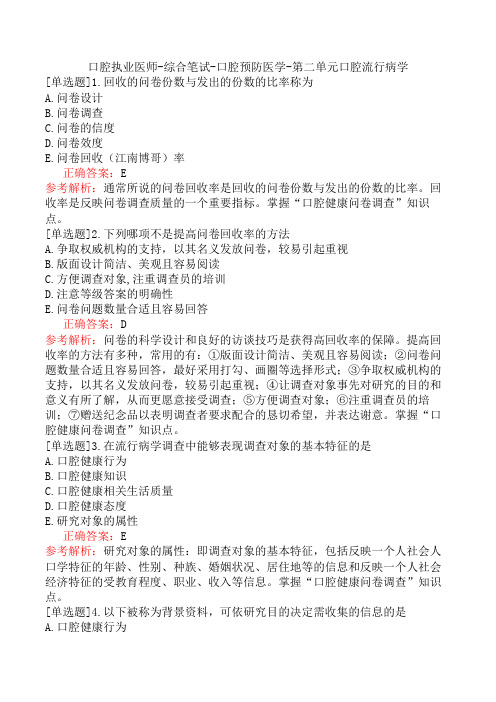
口腔执业医师-综合笔试-口腔预防医学-第二单元口腔流行病学[单选题]1.回收的问卷份数与发出的份数的比率称为A.问卷设计B.问卷调查C.问卷的信度D.问卷效度E.问卷回收(江南博哥)率正确答案:E参考解析:通常所说的问卷回收率是回收的问卷份数与发出的份数的比率。
回收率是反映问卷调查质量的一个重要指标。
掌握“口腔健康问卷调查”知识点。
[单选题]2.下列哪项不是提高问卷回收率的方法A.争取权威机构的支持,以其名义发放问卷,较易引起重视B.版面设计简洁、美观且容易阅读C.方便调查对象,注重调查员的培训D.注意等级答案的明确性E.问卷问题数量合适且容易回答正确答案:D参考解析:问卷的科学设计和良好的访谈技巧是获得高回收率的保障。
提高回收率的方法有多种,常用的有:①版面设计简洁、美观且容易阅读;②问卷问题数量合适且容易回答,最好采用打勾、画圈等选择形式;③争取权威机构的支持,以其名义发放问卷,较易引起重视;④让调查对象事先对研究的目的和意义有所了解,从而更愿意接受调查;⑤方便调查对象;⑥注重调查员的培训;⑦赠送纪念品以表明调查者要求配合的恳切希望,并表达谢意。
掌握“口腔健康问卷调查”知识点。
[单选题]3.在流行病学调查中能够表现调查对象的基本特征的是A.口腔健康行为B.口腔健康知识C.口腔健康相关生活质量D.口腔健康态度E.研究对象的属性正确答案:E参考解析:研究对象的属性:即调查对象的基本特征,包括反映一个人社会人口学特征的年龄、性别、种族、婚姻状况、居住地等的信息和反映一个人社会经济特征的受教育程度、职业、收入等信息。
掌握“口腔健康问卷调查”知识点。
[单选题]4.以下被称为背景资料,可依研究目的决定需收集的信息的是A.口腔健康行为B.口腔健康知识C.口腔健康相关生活质量D.口腔健康态度E.研究对象的属性资料正确答案:E参考解析:研究对象的属性资料也称为背景资料,可依研究目的决定需收集的信息。
掌握“口腔健康问卷调查”知识点。
口腔流行病学
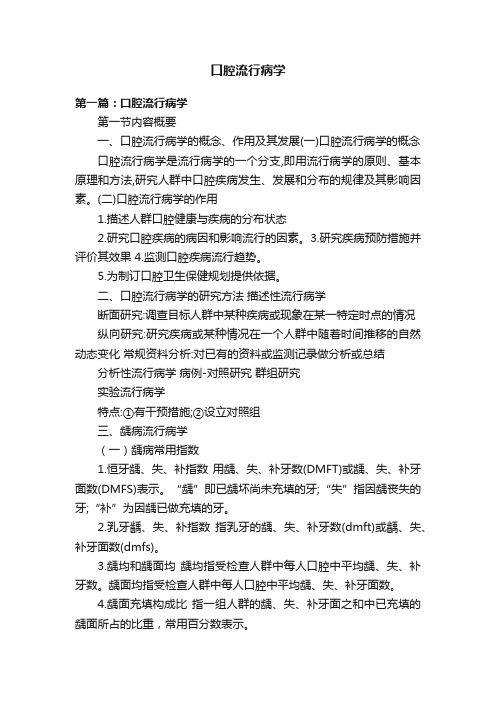
口腔流行病学第一篇:口腔流行病学第一节内容概要一、口腔流行病学的概念、作用及其发展(一)口腔流行病学的概念口腔流行病学是流行病学的一个分支,即用流行病学的原则、基本原理和方法,研究人群中口腔疾病发生、发展和分布的规律及其影响因素。
(二)口腔流行病学的作用1.描述人群口腔健康与疾病的分布状态2.研究口腔疾病的病因和影响流行的因素。
3.研究疾病预防措施并评价其效果4.监测口腔疾病流行趋势。
5.为制订口腔卫生保健规划提供依据。
二、口腔流行病学的研究方法描述性流行病学断面研究:调查目标人群中某种疾病或现象在某一特定时点的情况纵向研究:研究疾病或某种情况在一个人群中随着时间推移的自然动态变化常规资料分析:对已有的资料或监测记录做分析或总结分析性流行病学病例-对照研究群组研究实验流行病学特点:①有干预措施;②设立对照组三、龋病流行病学(一)龋病常用指数1.恒牙龋、失、补指数用龋、失、补牙数(DMFT)或龋、失、补牙面数(DMFS)表示。
“龋”即已龋坏尚未充填的牙;“失”指因龋丧失的牙;“补”为因龋已做充填的牙。
2.乳牙齲、失、补指数指乳牙的龋、失、补牙数(dmft)或齲、失、补牙面数(dmfs)。
3.龋均和龋面均龋均指受检查人群中每人口腔中平均龋、失、补牙数。
龋面均指受检查人群中每人口腔中平均龋、失、补牙面数。
4.龋面充填构成比指一组人群的龋、失、补牙面之和中已充填的龋面所占的比重,常用百分数表示。
5.患龋率指在调查期间某一人群中患龋病的频率,常以百分数表示。
6.龋病发病率指至少在1年时间内,某人群新发生齲病的频率。
7.无龋率指全口牙列均无龋的人数占全部受检查人数的百分率。
(二)流行特征及其影响因素1.齲病的流行特征从地区分布上看,各国齲病患病率差别悬殊。
从时间分布上看,发达国家患龋率逐渐下降,发展中国家龋病患病率逐渐上升。
从人群分布看,乳牙、年轻恒牙和老年人牙龈退缩后的恒牙易感齲病。
乳牙患龋率男性略高于女性,而恒牙患龋率女性略高于男性。
张课件-第二章-基本口腔流行病学2011
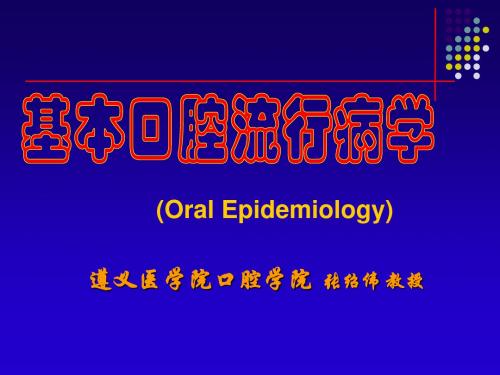
对照组 40.8 59.2
15.6 56.4 28.0
群组研究
群组研究(cohort study) ,是将特 定人群按其是否暴露于某因素分为两 组,追踪观察一定时间,比较两组的 发病率,以检验该因素与某疾病联系 的假设。如果暴露组人群的发病率显 著高于对照组人群,统计学检验有显 著意义,则可认为这种暴露因素与某 种疾病有联系。
龋病流行病学
理想的指数:
简单 价廉 客观 能反映疾病发展的不同阶段 能用统计学方法处理
龋病流行病学指数 恒牙龋失补指数:
D(decayed)M(missing)F(filled)T(teeth) D(decayed)M(missing)F(filled) S(surface)
乳牙龋失补指数:
dmft,dmfs
研究防治的策略,又评价效果 研究对象是人群
流行病学的发展
•对传染病的研究 •对慢性疾病的研究 •对疾病和健康的研究
口腔流行病学定义
口腔流行病学(oral epidemiology):是 流行病学的一个分支,即用流行病学的原 则、基本原理和方法,研究人群中口腔疾 病发生、发展和分布的规律及其影响因素 ,也研究口腔健康和影响健康的因素,为 探讨口腔疾病的病因、制定口腔保健计划 及口腔疾病防治策略和评价方法打下基础 。
横断面研究(cross-sectional study) 纵向研究(longitudinal study) 常规资料分析(studies analyzing
available routine data-sets)
分析性流行病学
分 析 性 流 行 病 学 ( analytic epidemiology ) 就 是 对 所 假 设 的 病因或流行因素进一步在选择的 人群中探索疾病发生的条件和规 律,验证病因假设。包括病例- 对照研究和队列研究。
(完整word)口腔预防医学
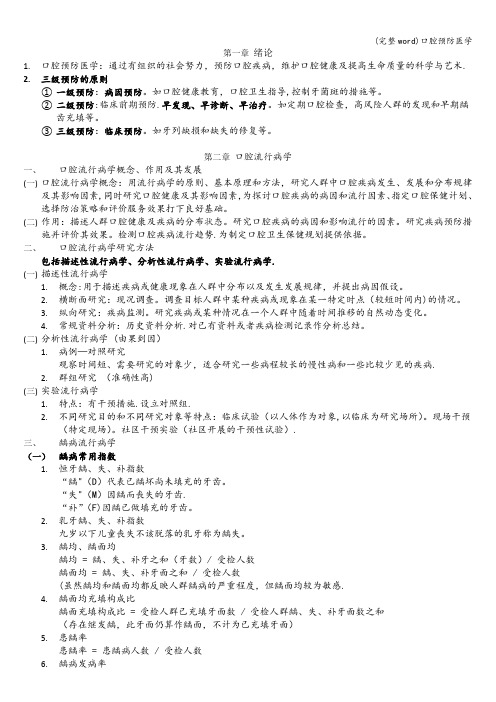
第一章绪论1.口腔预防医学:通过有组织的社会努力,预防口腔疾病,维护口腔健康及提高生命质量的科学与艺术.2.三级预防的原则①一级预防:病因预防。
如口腔健康教育,口腔卫生指导,控制牙菌斑的措施等。
②二级预防:临床前期预防.早发现、早诊断、早治疗。
如定期口腔检查,高风险人群的发现和早期龋齿充填等。
③三级预防:临床预防。
如牙列缺损和缺失的修复等。
第二章口腔流行病学一、口腔流行病学概念、作用及其发展(一)口腔流行病学概念:用流行病学的原则、基本原理和方法,研究人群中口腔疾病发生、发展和分布规律及其影响因素,同时研究口腔健康及其影响因素,为探讨口腔疾病的病因和流行因素、指定口腔保健计划、选择防治策略和评价服务效果打下良好基础。
(二)作用:描述人群口腔健康及疾病的分布状态。
研究口腔疾病的病因和影响流行的因素。
研究疾病预防措施并评价其效果。
检测口腔疾病流行趋势.为制定口腔卫生保健规划提供依据。
二、口腔流行病学研究方法包括描述性流行病学、分析性流行病学、实验流行病学.(一)描述性流行病学1.概念:用于描述疾病或健康现象在人群中分布以及发生发展规律,并提出病因假设。
2.横断面研究:现况调查。
调查目标人群中某种疾病或现象在某一特定时点(较短时间内)的情况。
3.纵向研究:疾病监测。
研究疾病或某种情况在一个人群中随着时间推移的自然动态变化。
4.常规资料分析:历史资料分析.对已有资料或者疾病检测记录作分析总结。
(二)分析性流行病学 (由果到因)1.病例—对照研究观察时间短、需要研究的对象少,适合研究一些病程较长的慢性病和一些比较少见的疾病.2.群组研究(准确性高)(三)实验流行病学1.特点:有干预措施.设立对照组.2.不同研究目的和不同研究对象等特点:临床试验(以人体作为对象,以临床为研究场所)。
现场干预(特定现场)。
社区干预实验(社区开展的干预性试验).三、龋病流行病学(一)龋病常用指数1.恒牙龋、失、补指数“龋"(D)代表已龋坏尚未填充的牙齿。
第二章基本口腔流行病学

描述性研究
提出可疑危险因素
病例对照研究
提出病因假设
队列研究
判定暴露与疾病因果关系
流行病学实验研究
进一步验证因果关系
? 问题 1:如果目前还没有有关食物与龋病关系的研 究证据,你将从哪些方面着手,采用什么研究方
法获取证据?请说明理由。
? 答: 临床医师的怀疑为病因研究提供了初步线索,作 为流行病学家应先进行描述性研究:收集已有资料或 进行现场调查了解龋病的分布,提出因果假设(龋病 患者食糖率高,食糖者龋病发病率高);再进行分析 性研究:包括病例对照研究和队列研究等,进一步验 证因果假设:由于医学伦理等原因,不能进行人群实 验,但可收集自然实验的资料,作为判断因果关系的 强有力的证据。在以上研究结果基础上,运用病因判 定标准作出综合评价。
二、分析性流行病学
? 1. 病例对照研究(又称回顾性研究) 探讨病因和相关因素对于疾病发生的影响。 时间上是先由“果”,后及“因”的回顾性研究 。
二、分析性流行病学
病例对照研究 病例组
人群 样本
对照组
Direction of data collection
有暴露 无暴露 有暴露 无暴露
二、分析性流行病学
第二章 基本口腔流行病学
流行病学
研究人群中疾病 与健康状况的 分布 及其影响因素 ,并制 订防制疾病及促进 健康的 策略和措施 的科学。
流行病学
疾病 人群
健康人
阐明规律 探索病因 制定对策 评价效果
预防控制 消灭疾病
目录
第一节 口腔流行病学的定义与发展 第二节 口腔流行病学的方法 第三节 龋病流行病学 第四节 牙周病流行病学 第五节 其它口腔疾病的流行病学 第六节 口腔健康调查的基本方法
口腔流行病学(1)
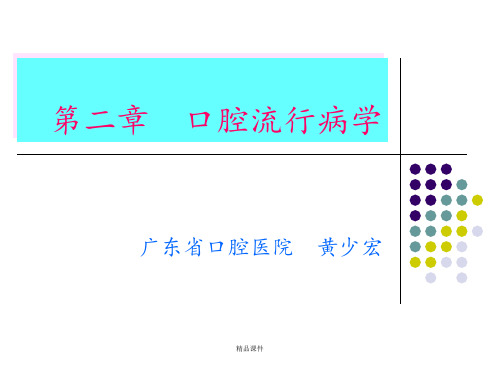
判断效果
患龋率
Newburgh 控制水氟浓度 1mg/L
精品课件
Kingston 0.1mg/L
4. 口腔疾病监测 定期调查、报告
精品课件
5. 制订口腔保健规划并评价其进展 依据——规划——
评估——调整—— 评价
精品课件
口腔流行病学的发展 斑釉牙 → 水氟浓度高 → 氟牙症 少斑釉牙地区——多龋
人群中的分布以及发生、发展的规律 客观描述,提出病因假设
精品课件
检查
二、分析性流行病学
精品课件
病例-对照研究 (case-control study)
探讨病因和相关因素 选择有特定疾病的人群,与未患这种疾病的对照 比较两组人群过去暴露于某可能因素的程度,分
析暴露是否与疾病有关 由“果”及“因”,回顾性研究
精品课件
群组研究 (cohort study)(队列研究)
暴露 未暴露
患病 未患病
患病
精品课件
未患病
特点 准确性高、观察暴露强度的影响 一种因素与多种疾病 观察时间长、成本高 用于检验较明确的因素
精品课件
分析性流行病学小结: 已假设病因和有关因素 探索疾病发生的条件和规律 验证病因假设
常规资料分析(历史资料分析) 对已有的资料或者疾病监测记录做分析或总结 如病史记录、疾病监测资料等
资料时间
2000.10 2003.10 2006.10
新生(男)
患龋率
龋均
60%
0.8
62%
0.9
65%
1.0 精品课件
新生(女)
患龋率
龋均
70%
1.2
71%
1.3
71%
1.3
- 1、下载文档前请自行甄别文档内容的完整性,平台不提供额外的编辑、内容补充、找答案等附加服务。
- 2、"仅部分预览"的文档,不可在线预览部分如存在完整性等问题,可反馈申请退款(可完整预览的文档不适用该条件!)。
- 3、如文档侵犯您的权益,请联系客服反馈,我们会尽快为您处理(人工客服工作时间:9:00-18:30)。
acceptance that the participant understands the conduct of
the trial and the nature of any risks involved.
龋病流行病学
Epidemiology of Dental Caries
口腔流行病学的研究方法
The Methods of Oral Epidemiology
3、实验性研究 experimental study
临床试验周期 Duration of the trial Clinical trials must be continued long enough to permit detection of new disease or extension of lesions already
口腔流行病学
Oral Epidemiology
口腔预防教研室
Department of Preventive Dentistry
流行病学定义
Definition of Epidemiology
流行病学是研究人群中疾病或健康状
态的分布及其影响因素,并研究防制疾病
及促进健康的策略和措施的科学。
(李立明 1999)
Eligible
subjects No disease Direction of data collection
3、实验性研究 Experimental epidemiology
现场观察和现场实验是流行病学的主要的研究 方法。前者是观察疾病的自然分布规律以及有关因 素,后者则使用人工手段以干预某一疾病的自然分
Epidemiology
1、描述人群口腔健康与疾病的分布状态
To describe the epidemic distribution of oral health and diseases in population 口腔健康调查(横断面调查) Oral health survey (cross-sectional survey) 通过对一个地区、某一人群在一定时间内的 某种或某些口腔疾病进行调查,获得该地区特定 人群某种或某些口腔疾病的患病情况和分布特点。
流行病学定义
Definition of Epidemiology
The study of the health and disease in populations, and of how these states are influenced by heredity, biology, physical environment, social environment, and ways of living. Burt (1999)
4、监测口腔疾病的发展趋势
To surveillance the trends of oral diseases in The population
口腔健康信息系统 Oral health information systems
Risk factors
surveillance status
Care & intervention
描述性流行病学是流行病学中最常用的一种, 它的作用对疾病或健康现象在人群中的分布以及发 生、发展的规律作客观的描述,提出病因假设。描 述性流行病学主要有下面几种:
1、横断面研究 (cross-sectional study)
横断面研究可以快捷经济的调查目标人群中某
种疾病或现象在某一特定时点上(较短的时间内) 的情况。它的作用在于了解疾病的患病情况和分布 特点,以便制定预防措施和为研究病因提供线索
3、常规资料分析 Routine data-sets analysis
又称历史资料分析,即对已有的资料或者疾病 监测记录做分析或总结。如病史记录、疾病监测资 料等。如因龋病、牙周病、外伤、修复需要等原因 而拔除病牙。这种研究结果可为开展口腔保健工作 提供必要的信息
2、分析性研究
病例-对照研究 (case-control study)
断该疾病可能的病因。
3、研究疾病预防措施并评价其效果
To study preventive measures for oral
diseases and evaluate the effectiveness
口腔流行病学也可用于口腔疾病预防措施和
预防方法的研究,并对其效果进行评价。
Oral epidemiology can be used to evaluate the efficacy
究方法是在时间上是先有“因”,后有“果”,属
(prospective study) 前瞻性研究。
Prospective study design
Exposed disease
Eligible
subjects Eligible No disease Unexpose d
subjects
disease
Exposed
NonCases
Unexposed Direction of data collection
2、分析性研究 Analytic epidemiology
群组研究 (cohort study)
又称队列研究,将特定人群按其是否暴露于某
因素分为两组,追踪观察一定时间,比较两组的发
病率,以检验该因素与某疾病联系的假设。这种研
口腔流行病学定义
Definition of Oral Epidemiology
口腔流行病学是用流行病学的原则、基本 原理和方法,研究人群中口腔健康与口腔疾病 分布的规律及其影响因素,为探索病因及其影 响因素,制定口腔健康目标和规划,选择疾病 防制策略和效果评价提供依据的科学。
口腔流行病学的作用
The Role of Oral
Very low: <5.0 Low: 5.0-8.9 Moderate: 9.0-13.9 High: >13.9 No data available
7
2、研究口腔疾病病因和影响流行的因素
To study the determinants of oral diseases and the epidemic factors 通过横断面调查可以提供某种或某些疾病的流 行因素线索,形成危险因子假设,然后用分析性流 行病学的研究方法对该危险因子进行验证,借以判
Quality & outcome
Oral health
Administration of care
5、制定口腔卫生保健规划并评价其进展
To plan and evaluate oral health care services and its process 口腔流行病学调查的结果是各级卫生行政部
National oral health survey of US was developed from 1960’s regularly for analyzing the trends of caries and periodontal diseases. National oral health survey in China is developed three times . ( 1983 yr, 1995yr and 2005yr )
present during the period of the trial.
防龋临床试验
牙周临床试验
口腔流行病学的研究方法
The Methods of Oral Epidemiology
3、实验性研究 experimental study
伦理问题 Ethical considerations
Humans taking part in clinical trials must give informed
2、纵向研究 (longitudinal study)
研究某种疾病或情况在一个人群中随着时间 推移的自然动态变化。也就是对一组人群定期随 访,两次或若干次横断面调查结果的分析。它的 作用在于动态地观察疾病或某种现象的演变情况 及其原因分析
2、纵向研究 (longitudinal study)
较为经典的纵向研究:在斯里兰卡茶叶工人中 进行的为期15年的纵向研究。研究只观察牙周病的 自然进展,不做任何治疗性干预。 根据不同牙齿和附着丧失的结果显示,8%为快 速进展型,81%为中度进展型,11%停留在牙龈炎水 平无进展。研究揭示了牙周病自然进展的重要信息。
探讨病因和相关因素对于疾病发生的影响。 选择有特定疾病的人群,与未患这种疾病的对照, 比较两组人群暴露程度,分析暴露是否与疾病有 关。这种研究方法是时间上是先由“果”,后及
(retrospective study ) “因”的回顾性研究。
Retrospective study design
Exposed Cases Unexposed
口腔流行病学的研究方法
The Methods of Oral Epidemiology
1、描述性研究 Descriptive epidemiology
2、分析性研究 Analytic epidemiology
3、实验性研究 Experimental epidemiology
1、描述性研究 Descriptive epidemiology
布规律,探索某一因素是否为流行因素或某一措施
是否有效。
口腔流行病学的研究方法
The Methods of Oral Epidemiology
3、实验性研究 experimental study
临床实验 (clinical trial) 现场实验 (field trial) 社区干预实验 (community intervention trial) “类实验”或“准实验”(semi-experiment)
